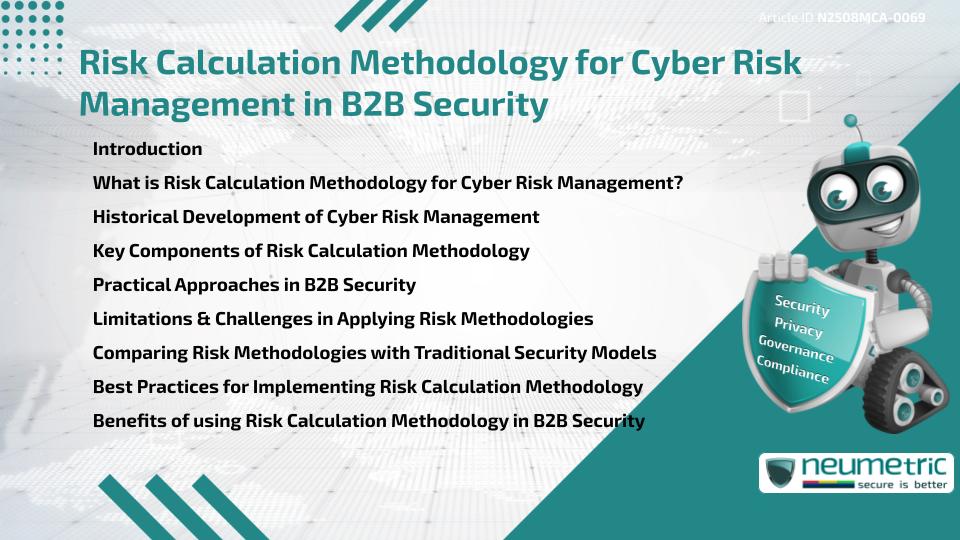Table of Contents
ToggleIntroduction
Risk calculation methodology for cyber Risk Management is a structured way of identifying, evaluating & quantifying Digital Threats. It allows businesses to measure Vulnerabilities, estimate potential losses & allocate resources effectively. In B2B security, this methodology plays a crucial role in preventing disruptions, maintaining Trust & safeguarding Sensitive Information. Unlike generic security approaches, this method provides data-driven insights, balances Risk tolerance with Financial planning & supports Regulatory Compliance. By combining historical trends, mathematical models & practical applications, Organisations gain a reliable Framework for decision-making.
What is Risk Calculation Methodology for Cyber Risk Management?
The Risk calculation methodology for cyber Risk Management refers to a systematic process that assigns measurable values to Cybersecurity Threats. Instead of treating Risks as abstract concepts, it breaks them down into probability, impact & mitigation costs. This Framework ensures that businesses do not simply invest in technology reactively but prioritise based on potential outcomes. For example, if the probability of a phishing attack is high & the impact includes Financial & reputational damage, then Organisations can justify stronger investments in Employee Training & detection tools.
Historical Development of Cyber Risk Management
Cyber Risk Management has evolved significantly since the early days of Information Security. In the 1980s & 1990s, companies mainly relied on antivirus software & firewalls without structured measurement tools. With the rise of internet-based commerce in the early 2000s, Organisations recognised the need for quantitative Risk Assessments. Standards such as ISO 27001 & frameworks like NIST introduced structured approaches, emphasising the importance of Risk calculation methodology for cyber Risk Management. Today, B2B security strategies incorporate advanced analytics, drawing lessons from both historical data & emerging cyber trends.
Key Components of Risk Calculation Methodology
The methodology typically revolves around three main elements:
- Likelihood of Threat Occurrence: Estimating how often a Cyber Incident may happen using historical data & predictive models.
- Impact Assessment: Calculating the possible financial, operational & reputational costs of an Incident.
- Control Effectiveness: Measuring how well Security Measures reduce or transfer the Risk.
These components form the foundation for quantitative assessments such as Annualised Loss Expectancy [ALE] or qualitative scales such as high, medium & low Risk ratings.
Practical Approaches in B2B Security
In B2B environments, companies share Sensitive Data, integrate systems & depend on mutual trust. Risk calculation methodology for cyber Risk Management becomes vital in evaluating Vendor reliability, supply chain exposure & Compliance with International Regulations. For example, a Financial services company may assess the Risks of Third Party payment processors by calculating potential losses in case of a data breach. Practical approaches often include Vulnerability assessments, Penetration Testing & Scenario-based modeling.
Limitations & Challenges in Applying Risk Methodologies
Despite its strengths, the methodology faces challenges. Data for accurate probability calculations may be incomplete or outdated. Estimating Financial impact can also be subjective, particularly for reputational damage. Moreover, smaller businesses may lack the resources to adopt comprehensive models. Overreliance on numbers may create a false sense of security, while ignoring qualitative insights may lead to blind spots.
Comparing Risk Methodologies with Traditional Security Models
Traditional security models often focused on defense-in-depth strategies without detailed measurement. While effective in preventing known attacks, these models did not provide Financial justification or prioritise Risks effectively. By contrast, Risk calculation methodology for cyber Risk Management brings Accountability & Transparency to decision-making. It bridges the gap between technical teams & executive leadership by translating Threats into business terms.
Best Practices for Implementing Risk Calculation Methodology
Businesses implementing this methodology should:
- Regularly update Threat data & probability models.
- Include both qualitative & quantitative assessments.
- Train staff to interpret results for strategic planning.
- Align Risk Assessments with Compliance standards like GDPR & HIPAA.
- Involve Vendors & partners in joint Risk Assessments.
Following these Best Practices ensures that calculations remain relevant & actionable.
Benefits of using Risk Calculation Methodology in B2B Security
Adopting this methodology provides multiple benefits. It enables better allocation of Cybersecurity budgets, builds trust between partners & demonstrates Compliance during Audits. Companies can use it to strengthen negotiations with Vendors, proving due diligence in Risk-sharing agreements. Ultimately, it enhances resilience, ensuring that Business Operations remain uninterrupted even in the face of evolving Cyber Threats.
Takeaways
- Provides a structured & measurable approach to cyber Risks
- Combines probability, impact & control effectiveness
- Supports Compliance with international standards
- Strengthens B2B relationships & Vendor trust
- Enhances resource allocation & resilience
FAQ
What is the main purpose of Risk calculation methodology for cyber Risk Management?
Its main purpose is to provide measurable insights into Cybersecurity Risks, helping Organisations allocate resources effectively & prevent disruptions.
How does it differ from traditional security models?
Unlike traditional models that focus only on prevention, this methodology quantifies Risks, prioritises Threats & ties them to Financial & operational impacts.
Why is it important for B2B security?
It ensures Trust, Compliance & Operational Stability by allowing businesses to assess Risks in shared data, Vendor systems & supply chains.
What are common challenges in applying this methodology?
Challenges include incomplete data, difficulties in estimating reputational damage & limited resources for Small Businesses.
Can Small Businesses use this methodology effectively?
Yes, but they may need to adapt simplified models or use Third Party services due to limited expertise & resources.
How does Risk calculation methodology support Compliance?
It aligns with standards like ISO 27001 & NIST by documenting measurable Risks & demonstrating accountability during Audits.
What are examples of practical applications in B2B security?
Examples include assessing Vendor Risks, evaluating supply chain exposure & justifying investments in security training or technologies.
Need help for Security, Privacy, Governance & VAPT?
Neumetric provides organisations the necessary help to achieve their Cybersecurity, Compliance, Governance, Privacy, Certifications & Pentesting needs.
Organisations & Businesses, specifically those which provide SaaS & AI Solutions in the Fintech, BFSI & other regulated sectors, usually need a Cybersecurity Partner for meeting & maintaining the ongoing Security & Privacy needs & requirements of their Enterprise Clients & Privacy conscious Customers.
SOC 2, ISO 27001, ISO 42001, NIST, HIPAA, HECVAT, EU GDPR are some of the Frameworks that are served by Fusion – a SaaS, multimodular, multitenant, centralised, automated, Cybersecurity & Compliance Management system.
Neumetric also provides Expert Services for technical security which covers VAPT for Web Applications, APIs, iOS & Android Mobile Apps, Security Testing for AWS & other Cloud Environments & Cloud Infrastructure & other similar scopes.
Reach out to us by Email or filling out the Contact Form…


